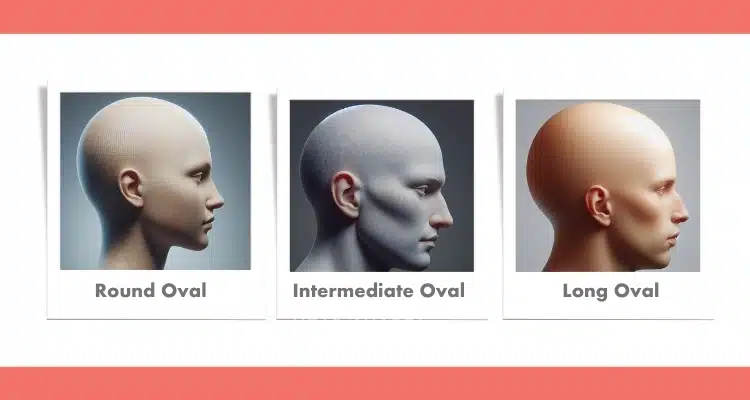Ensuring your helmet fits is not just about comfort; it can potentially compromise your safety, which is the most fundamental reason to wear a helmet. Helmets reduce the risk of head injuries by 88%. However, an ill-fitting helmet can cause more severe concussions and overall provide much less head injury protection.
A well-fitted, snug helmet is the key to road safety, and measuring your head circumference will help you inch one step closer to it. It’s not a hard procedure, either. But remember that your head shape, along with the circumference of your head, is a significant factor in proper helmet sizing.
To measure the circumference of your head for a helmet, grab a tape measure and wrap it around, starting from the middle of your forehead, about 2.5 cm above your eyebrows. Circle it around the natural rise on the back of your head, and go with the largest measurement.
Read on for a detailed step-by-step guide on how to measure head circumference for helmet.
Table of Contents
Steps to Measure Head Circumference for Helmet
Preparing to Measure Head Circumference: What You’ll Need
Before you set off to calculate your head size, ensure that you have all the necessary tools to ensure an accurate result.
Measuring tape:
First off, you’ll require a tape measure. It should be soft, flexible, and straight for level placement. Regardless, if you find yourself short of one, don’t fret.
How to measure head size for helmet without tape
You can also measure your head size for a helmet without tape. Use a string or anything of that sort (knitting yarns, charging cables, and soft wires work just fine). Anything long enough to be comfortable wrapped around your head will work.
Make sure that it is not flexible, though. Moreover, whatever you use, it should remain straight and, thus, maintain the integrity of the measurement.
Ruler:
If you use any string instead of a tape measure, you’ll need a hard ruler to measure up the string against.
Pen and Paper:
Keep a pen and paper nearby to note down the measurements.

An Assistant:
You can go solo, but getting someone to assist will make the circumference measurements easier. If it’s a child, you can help measure their head for them.
Mirror:
If you’re doing this alone, keep a mirror around. This way, you can ensure you’re measuring correctly and the string remains straight. Even if you have an assistant, you can keep one with yourself for confirmation.
How to take head measurements for helmet:
Now that you’ve assembled your toolkit to measure your head circumference for a helmet, let’s start.
Begin at Your Forehead:
Place your tape or string right in the middle of your forehead, about an inch (or 2.5 cm, as mentioned previously), above your eyebrows. Confirm that the tape wraps horizontally across your forehead in a level plane. This marks the starting point of the measurement.
Wrap Around the Head:
Move the tape around the back of your head. Guarantee that it sits snugly, about 1.3 cm (½ inch) on top of your ears and the most prominent part on the back of your head. Maintain a level circumference to capture the true size.
Meet at the Front:
Bring that tape back to the starting point in the middle of the forehead. Double-check to ensure that the tape is neither too tight nor too loose. It should fit comfortably yet securely around the perimeter of your head for proper helmet sizing. If you’re doing it yourself, use the mirror to ensure the tape is straight.
Record the Measurement:
Record the measurement once the two ends of the tape meet at the forehead. This will be your head circumference for a helmet. Note the value in both cms and inches so you’re well-prepared for a helmet sizing guide from any company. Usually, they have these measurements in either inches or cm.
Repeat this process three to four times and note the measurements each time. Take the largest size obtained as the final one. Add 1 cm to maintain a comfortable fit if you wear a cap or a certain hairstyle.
The same guideline applies to measuring head circumference for ski, car, motorcycle helmets, etc., as well as hats, caps, and most headwear. Therefore, helmet size can also be referred to as the hat size.
Matching Measurement with Helmet Sizing Chart
Different companies have different sizing standards. Some may have the measurements of their helmets in centimeters only, and others in inches. Many companies only have S, M, L, and XL for different helmet size ranges.
Below is the size chart for Shoei, Arai, Shark, Klim and Scorpion motorcycle helmets.
You should look up the company’s size guide and other things to consider before buying a motorcycle helmet. Figure out the range your head circumference measurement for the helmet belongs to. The range is usually different for adults and child’s head size. Some adults with small heads can fit well in the larger sizes of the child’s helmet size range.
Many contemporary bike helmet sizes are adjustable. Most commonly, you’ll find fit pads or rings to adjust the helmet size. Adjust the tension on the ring so it comes down to your head size, or tweak around with the fit pads to get the ideal snugness.
This option is less common in motorcycle helmets. Refer to motorcycle helmet size guides to find your best option, but if that fails, there are certain alternatives concerning customization, including padding. These differences arise primarily due to our different head shapes.
How Head Shape Affects Measurement and Helmet Size
Before you cross-reference a measurement with a helmet sizing guide from a company, know that your head circumference measurement for the helmet isn’t the only thing important. Your head shape can also affect the fit of your lid.
You can only know this after you try on a helmet; therefore, physical testing is important. Head shapes typically fall into categories like round oval, intermediate oval, and long oval.

As per the National Highway Traffic Safety Administration, you should try on a helmet for at least half an hour before taking it out for a ride. Feeling pressure on your forehead indicates that the helmet is too round for your head. If the pressure is centered at your cheeks, the helmet is too oval for your round face shape.
Avoid moving too far up sizes to get the helmet to work out. You can tweak around the padding, as mentioned above. But if you have to add a bit of padding, then the size is too big for you.
How Should Your Helmet Fit?
When you wear the helmet, it should not press too tight, but neither should it be so that you can move your head freely inside it. The helmet should fit well on your face. A great indication of an ill-fitting helmet is too much noise that seems to be seeping in through the helmet.
To check if the motorcycle helmet fits nicely, put a hand on the back of your helmet and one below where the chin strap is, and give it a few tugs. Your head should not move freely in your helmet. The helmet should not indicate leaving the lower part of the back of your head defenseless, either.
Now grab the front of your helmet and the chin strap and give a few tugs in different directions. Again, the helmet should not leave parts of your head unguarded. If the helmet rattles, it is a size much bigger than your original value of head circumference for the helmet.
Consequences of Ill-fitting Helmet
Measuring your head circumference properly for a well-fitting helmet is also crucial because if the helmet is too tight, it will become a source of continuous discomfort over time. The possibility of compression headaches increases, from mild ones to migraines. Then there’s the obstructed vision and reduced blood flow to the head.
However, the danger of an excessively loose helmet (lets your head move more than half an inch inside) is far greater than one that is too tight.

If you are in between helmet sizes, we suggest you opt for the smaller fit and prioritize safety over comfort. This is because a loose-fitting helmet may just get thrown completely off the head in case of an accident and provide no protection at all.
In the worst-case scenario, the helmet can slip off, and end up suspended from the hyoid bone. If the helmet jerks back violently, as in the case of most accidents, it can result in severe neck injuries, which although rare, is proven possible with a recorded case.
FAQs
Which helmet size should I go for if I'm between sizes?
Generally, we suggest opting for the smaller size as described earlier. However, when it comes to individual head shapes, a bigger size may not be as “big” on your specific head shape. It may be a problem fixable with some padding. You should weigh your options and the risks involved carefully.
What size helmet is best for a 22-inch head?
This is the average male head’s circumference (21 inches for females), and you’re probably a size medium so start with that range. Of course, this is subject to variation too depending upon the company, although more often than not, it’ll be included in the medium range.
Is there any one-size-fits-all for motorcycle helmets?
There’s no concept of one-size-fits-all in the world of helmets. There are certain adjustable helmets, but even their magic has limits. Measure your head’s circumference for the helmet so you can get a perfect size.
Where is the size of a helmet written?
The size of a helmet (head circumference for it) is written prominently on the package of the helmet. If you don’t have the package anymore, check the back of the helmet or the inside where the padding is.
Can I buy my kid a bigger helmet?
Since children’s heads grow pretty fast, many parents consider buying a bigger helmet that the child may eventually grow into. Wrong practice, never buy your child a loose helmet and compromise their safety.
Conclusion:
Measuring the head circumference of a helmet is a simple procedure. You can grab a tape measure and note the value you get by wrapping it from the middle of the forehead, around your head bump, and back. Ensure that you place your measuring device level against your forehead right above your eyebrows.
Take the measurement multiple times and choose the largest one. Afterward, you can cross-reference with helmet sizing guides from wherever you’re buying from. You can read the detailed head sizing guide above, along with instructions on ascertaining that you found the right fit.


1 thought on “A guide on how to measure head circumference for helmet”
Comments are closed.